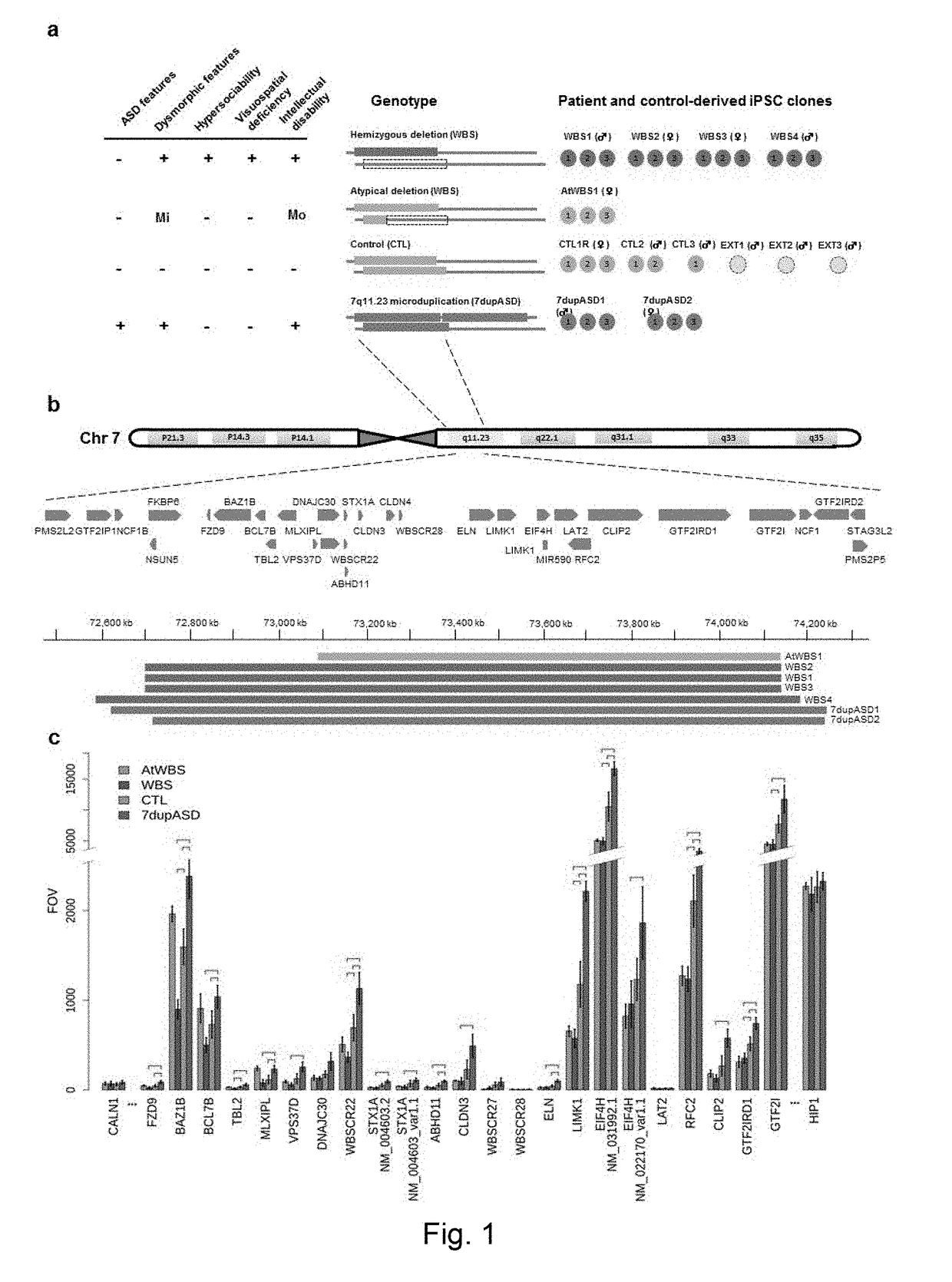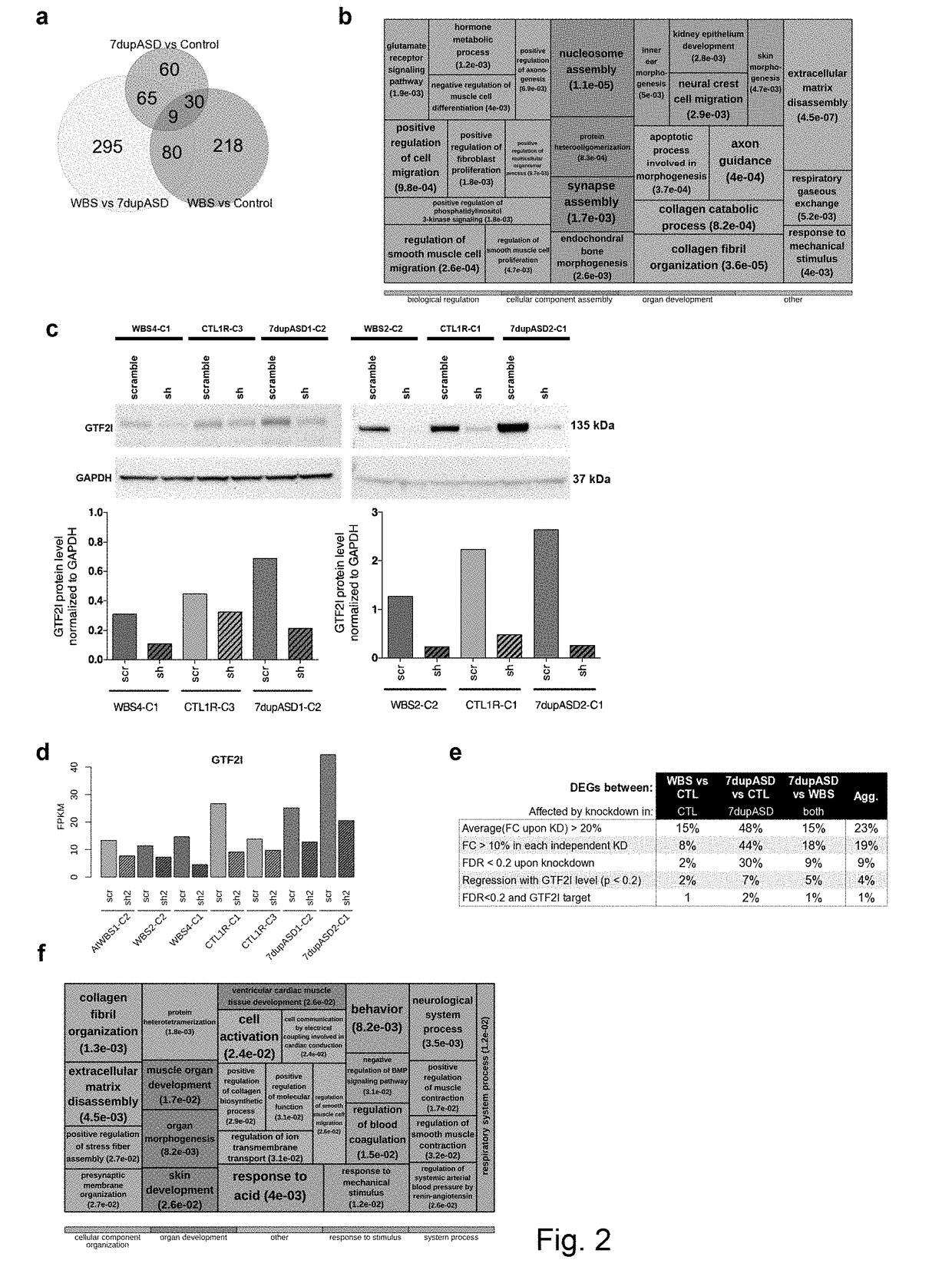Reprogramming-based models of neurodevelopmental disorders and uses thereof
a neurodevelopmental disorder and reprogramming technology, applied in the field of ipsc, can solve the problems of lack of reproducibility and stability, impeded the establishment of robust, scalable, high-throughput screening assays for autism spectrum disorders (asds), and difficulty in developing drugs for asd,
- Summary
- Abstract
- Description
- Claims
- Application Information
AI Technical Summary
Benefits of technology
Problems solved by technology
Method used
Image
Examples
example 1
ment of a Large Cohort of Transgene-Free Induced Pluripotent Stem Cell Lines from WBS and 7dupASD Patients
[0172]The inventors selected a highly informative cohort of WBS and 7dupASD patients, whose fibroblast biopsies were deposited in the Genomic and Genetic Disease Biobank (http: / / www.telethon.it / en / scientists / biobanks) and who were assessed by a multidisciplinary team of specialists for a detailed clinical record (FIG. 1a and Table 3).
TABLE 3Clinical features of patientsGDB192 / GDB306 / GDB316 / GDB361 / GDB339 / GDB242 / WBS154WBS276WBS301WBS309WBS302GDB CFWBS202Clinical featuresAtWBS1WBS4WBS2WBS3WBS17dupASD17dupASD2Intellectual disabilityModerateModerateModerateModerateModerateModerateModerateCardiovascularSupravalvular aortic−+−−+NANAstenosisPeripheral pulmonary−−−+−NANAstenosisValvular pulmonic−+−−−NANAstenosisHypertension−−NA−+NANAOthers−−−left−NANAventricularhypertrophy:interatrialseptaldefectCraniofacialWide mouth+−+−+NANAProminent ear lobes−−−++NA+Dolicocephaly−++−−NANABroad forehea...
example 2
n of 7q11.23 Genes Follows Gene Dosage in the Pluripotent State
[0175]In order to ascertain whether the pluripotent state represented a meaningful stage at which to probe the effect of 7q1.23 dosage, the inventors first asked whether the mRNA expression of the 7q1.23 genes follows gene dosage. For this the inventors resorted to the high accuracy of Nanostring-based quantitation as well as to RNAseq and found that the expression of all genes of the interval (including those expressed at very low levels) mirrors gene dosage (FIG. 1c and FIG. 13a), thus excluding compensatory effects from the wild type allele. The inventors then confirmed that also at the protein level the expression of both GTF2I and BAZ1B, the genes associated to key traits of WBS and 7DupASD34,41-45, reflected the symmetrical dosage of the two conditions (FIG. 13b-c-d).
example 3
osage Imbalance Causes Transcriptional Dysregulation in Disease-Relevant Pathways Already at the Pluripotent State
[0176]To assess differential expression between genotypes, the inventors profiled by RNAseq the panel of patient- and control-derived iPSC lines, and complemented this dataset also with additional control lines from the literature (hereafter referred to as external controls, see methods), excluding from further analysis the genes that were differentially-expressed between controls from the inventors' cohort and external controls. A pair-wise comparison of the three genotypes identified 757 differentially-expressed genes (DEGs) (FIG. 2a). Strikingly, Gene Ontology (GO) analysis of the union of DEGs revealed significant enrichments for biological processes of obvious relevance for the hallmark phenotypes and target organ systems of the two conditions.
[0177]FIG. 2b shows a treemap representation of the most specific enriched biological processes, in which square sizes are p...
PUM
| Property | Measurement | Unit |
|---|---|---|
| Density | aaaaa | aaaaa |
| Disorder | aaaaa | aaaaa |
| Morphology | aaaaa | aaaaa |
Abstract
Description
Claims
Application Information
 Login to View More
Login to View More - R&D
- Intellectual Property
- Life Sciences
- Materials
- Tech Scout
- Unparalleled Data Quality
- Higher Quality Content
- 60% Fewer Hallucinations
Browse by: Latest US Patents, China's latest patents, Technical Efficacy Thesaurus, Application Domain, Technology Topic, Popular Technical Reports.
© 2025 PatSnap. All rights reserved.Legal|Privacy policy|Modern Slavery Act Transparency Statement|Sitemap|About US| Contact US: help@patsnap.com



